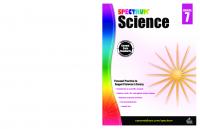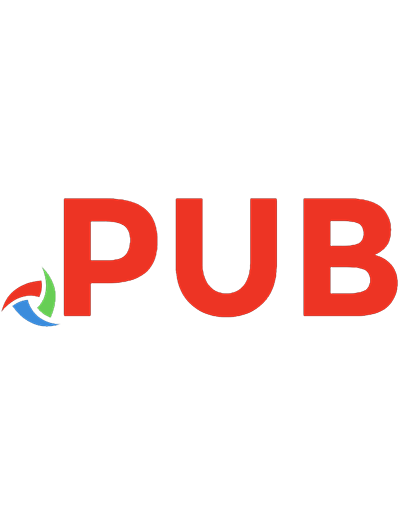A workbook prepared for use in second semester life science on the tenth grade level
538 33 4MB
English Pages 93
Polecaj historie
Citation preview
A WORKBOOK PREPARED FOR USE IN SECOND SEMESTER LIFE SCIENCE ON THE TENTH GRADE LEVEL
A Project Presented to the Faculty of the School of Education The University of Southern California
In Partial Fulfillment of the Requirements for the Degree Master of Science in Education
hy Katherine Hope Hanson August 1950
UMI Number: EP46344
All rights reserved INFORMATION TO ALL USERS The quality of this reproduction is dependent upon the quality of the copy submitted. In the unlikely event that the author did not send a complete manuscript and there are missing pages, these will be noted. Also, if material had to be removed, a note will indicate the deletion.
Dissertation Publishing
UMI EP46344 Published by ProQuest LLC (2014). Copyright in the Dissertation held by the Author. Microform Edition © ProQuest LLC. All rights reserved. This work is protected against unauthorized copying under Title 17, United States Code
ProQuest LLC. 789 East Eisenhower Parkway P.O. Box 1346 Ann Arbor, Ml 48106- 1346
££
'si H-^st P r ‘^-
T his project report, w ritten under the direction of the candidate’s adviser and app ro ved by h im , has been presented to and accepted by the F a c u lty o f the School of E d u catio n in p a r t ia l fu lfillm e n t of the requirements f o r the degree
of M a s t e r of
Science in Education.
Dat
.......... ...........................
(J
A d v is e r
Dean
TABLE OF CONTENTS Section A CHAPTER I.
PAGE
THE PROBLEM
..................................
1
...........
1
.................
1
Statement of the problem Setting of the problem
•• . .
Organization of the project
•. .
.........
bi
section B YOU AND YOUR LIFE 1.
HOW MAN BECOMES AWARE OF HIS ENVIRONMENT Part 1
. • .
8
Structure and Function of the Nervous
S y s t e m ..................................
8
Preview ....................................
8
References
................................
9
Problem 1
What are t r o p i s m s .............
9
Problem 2
What are reflexes
Problem 3
What are i n s t i n c t s ..........
Problem b
What are h a b i t s ...............
Problem 5
What is the unit of structure of
•
........
11 .
the nervous s y s t e m ..................... Problem 6
.................
Organs
12
lb
What are the parts of the
sympathetic nervous system Part 2
12
What are the parts of the
central nervous system Problem 7
11
.............
16
Structure and Function of the Sense 16
iv CHAPTER
PAGE P r e v i e w ................... • • ...
16
R e f e r e n c e s ..........
17
Problem 1
How we see • • • • • • . • • • •
18
Problem 2
How we h e a r ...................
20
Problem 3
How closely related are the
*
senses of taste and Problem b Part 3
smell • • • • • • • •
What is the sense of toiich
M a n fs Mind
.
Preview . . . . . . .............
. ♦ .
2b
• • .*
25
25
R e f e r e n c e s .............. ..................
26
Problem 1
What is intelligence • • • • • •
26
Problem 2
What is mental h e a l t h ........
28
Problem 3 Part b
What is mental illness *
Work of the Endocrine System
.. . •
30
•• • .
30
Preview . . . . ............ .. ............
30
References
• ..............................
31
Problem 1
What is an endocrine gland . . .
32
Problem 2
What are the functions of
endocrine glands II.
22
. . . . .
CONSERVATION OF HUMAN L I F E ......... Part 1
Disease and Its
. 35
Cause. . . . . . . .
P r e v i e w ......... *........................ R e f e r e n c e s ......................
32
38
35 35
V
CHAPTER
PAGE Problem 1
What is disease
Problem 2
What are the characteristics of
microbes Problem 3
•• • • • • • •
* • • • • • • • • • • • • • • •
• • .........
Prevention and Control of Disease
Preview References Problem 1
*+3
• •
...................
b5 *+5
.......................
*+6
How does your body defend itself
against invasion ........ Problem 2
37
What are the characteristics of
other pathogenic organisms Part 2
36
b6
• • • • • • • •
What are the characteristics of
certain infectious d i s e a s e s .............
*+8
III. CONTINUATION OF L I F E ............................
58
Part 1
Spontaneous G e n e r a t i o n ...............
P r e v i e w .............. References Problem 1
.
................
53 58
Can life start from dead organic
substances • ................. Part 2
53
. . . . . .
58
Asexual Reproduction . . . • • • • • •
61
Problem 1
What is reproduction by
fission .
61
Problem 2
What is reproduction by
budding .
6l
Problem 3
What is reproduction by
spores .
62
Problem b
What is vegetative reproduction
.
62
vi CHAPTER
PAGE Part 3
Methods of Sexual Reproduction
in P l a n t s ..................................
63
Preview .
63
• ...............................
R e f e r e n c e s ..............
• • • . .........
6^
sex c e l l s .............
65
Problem 1
Whatsisconjugation
Problem 2
What are
Part
Reproduction in Higher Animals
Preview • • . . References
6h
• • .
67
.......... .. ............
. . . . . . .
67
68
................. .
68
.
.
72
Problem 3
How does a girl become a woman
•
73
Problem b
What are the characteristics of
Problem 1
Where to look for information
Problem 2
How does a boy become a man
human d e v e l o p m e n t ....................... Problem 5
Why are people like their
a n c e s t o r s ................................ BIBLIOGRAPHY
75
. . . . . . .
..........................
77 80
LIST OF TABLES TABLE 1.
PAGE Total Reading Grade Placements for the 19*+75 19*+8, and 19*+9 Freshman Classes
II.
• • • • •
3
Learning Capacity of the Freshman Class of - 1 9 ^ 9 ......................................
5
LIST OF FIGURES FIGURE
PAGE
1.
A Typical N e u r o n .............
13
2.
The Human B r a i n ...............
15
3.
The Human E y e ...................- ...........
k-.
The Human E a r .....................
.
19 21
CHAPTER I STATEMENT OF THE PROBLEM A large amount of published material has been made available for use in Life Science on the tenth grade level. There are numerous
W o r k b o o k s 1, or laboratory guides, and
certainly as many texts, which deal adequately with the subject-matter.
Even in view of this mass of published
material, there remained a need for a student 1workbook1 of a still different type for Life Science.
The need was for
a 'workbook1 devoted to problems of daily living;
one
that would make the student acquainted with himself, his physical, mental, and emotional urges and needs.
At the
same time this 'workbook' must appeal both to students who are college preparatory, and to a majority of students who may never have any other exposure to a science course, some of them barely finishing high school.
Thus the ’work
book* has of necessity omitted much of the basic material on lower forms of life, and has mentioned their place in the total picture only briefly. SETTING OF THE PROBLEM The geographic area in which this 'workbook* will be used has numeTous diversities.
The total population of
the school district is sixty-five thousand, with a high
school population of three thousand divided between two high schools.
The Life Science course is required for grad
uation, and is offered' on the tenth grade level to segre gated classes.
The purpose of the segregation is to allow
greater emphasis on problems of family life and relation ships between the sexes. About fifty per cent of the fathers and mothers are employed in the metropolitan Los Angeles area, thus placing the school district largely in a suburban area.
However,
the area includes agricultural pursuits of many types, in cluding fruit growing and dairy farming, as well as small industries and businesses.
There is now in progress a
survey conducted by Gunnar L. Wahlquist, Director of Guid ance for the school district, to reveal the economic status of the district,.
At the present tabulation it seems likely
that the status will prove to be definitely low average in income. Of the three thousand students in the high school population, there was a sixty-five per cent turnover during each of the two school years of nineteen forty-eight and forty-nine, and nineteen forty-nine and fifty.
Presumably
a good part of this turnover was the result of the seasonal nature of much of the employment in the area. Of those graduating from the high schools of the district, only four per cent will go to a four year college,
3 TABLE I TOTAL READING GRADE PLACEMENIfOR THE FRESHMAN CLASSES OF 1947, 19^8. 19^9
36 J,to
Jf JO
3
.
o
-
3
M
*
:
o
-
£
i
t.o
L S -< *> -'7 . U . S - 7 . ? Zo - f - i 9 . r - M
767 Students; Actual G.P., -.7; M.A.G.P., -lk829 “ ....... ......
828
?.o
~ f . y 9 . 3'- 9. ? to. O -to. y / o. S-to.9 (








![Spectrum Math Workbook, Grade 7 [Workbook ed.]
1483808750, 9781483808758](https://dokumen.pub/img/200x200/spectrum-math-workbook-grade-7-workbooknbsped-1483808750-9781483808758.jpg)
![Cambridge IGCSE and O Level Computer Science Computer Systems Workbook [Workbook ed.]
1398318493, 9781398318496](https://dokumen.pub/img/200x200/cambridge-igcse-and-o-level-computer-science-computer-systems-workbook-workbooknbsped-1398318493-9781398318496.jpg)
